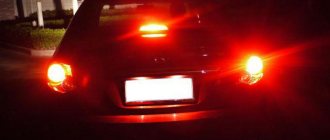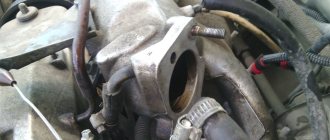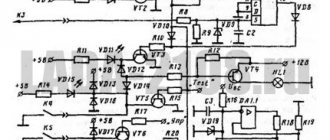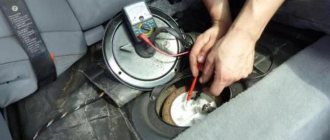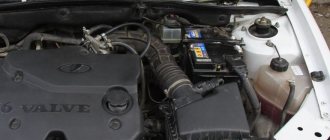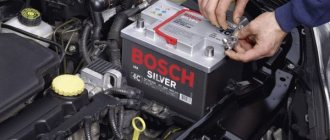The vehicle's electrical network is connected to a common “minus”, or mass, which is the entire body. That is, the body as a mass on the VAZ 2114 represents a single source of negative charge. And the source of negative charge is the connection between the case and the negative terminal of the battery.
If the wires connected from the electrical network to ground oxidize (come off), problems arise with the electronics, engine or control system. In case of typical “mass” faults, for example, “blinking” of the rear lights instead of turning on the turn signal or poor cranking of the starter, first check the condition of the wires connected to ground and contact points.
Weight of VAZ 2114
Installation of additional ground wire VAZ 2114: secrets of an auto electrician
To operate the electrical equipment of any modern passenger car, a constant voltage of 12 Volts is used. The power supply circuit is two-wire - the negative bus is the body or engine housing, the plus is supplied from the battery through wires to various circuit devices. If the negative oxidizes or there is no contact, various problems are possible in the electrical circuit of the car. Each car has main places where the mass is attached. To solve problems with the electrical part, you need to know where the main negative points are on the body and power unit. Another minus is often called the common wire.
The mass is attached to the body of a VAZ 2114
Power supplies
On the vast majority of modern cars, the power source is a three-phase alternating current synchronous generator driven by the main engine; three-phase alternating current from the generator is supplied to the built-in three-phase rectifier and voltage regulator circuit - in modern cars the voltage regulator is built into the generator housing. A car battery is used to provide constant and continuous power to some consumers when the engine is not running, such as lighting, car radio, brake lights, anti-theft alarm, as well as to fully power all vehicle systems when the engine is started. After starting the engine, the battery is recharged from the generator, and then it works in a buffer with the generator, smoothing out voltage drops when connecting powerful consumers. The generator power of a modern middle-class passenger car ranges from about 900-1300 watts.
Older cars used DC generators that were larger and heavier than three-phase generators; To maintain a constant voltage, a relay regulator was used, consisting of three devices - a voltage regulator, a current limiter and a reverse current relay.
In a number of cases, on special-purpose vehicles, as well as on armored vehicles, an additional generator driven by a separate internal combustion engine (the so-called auxiliary power unit) is installed, which makes it possible to supply consumers with electricity regardless of the operation of the main engine.
These include: switches and switches, relays, fuses, connector blocks, distribution and switching boxes, as well as power units.
Weight of VAZ 2114
Unreliable weight on the VAZ 2114 or its absence leads to various unpleasant surprises. For example, instead of a turn signal in the rear light, the lights suddenly start blinking (the so-called Christmas tree), or the starter barely turns. If you know where the masses of the VAZ 2114 are located, you can cope with many troubles in the electrical part of the car.
Location of common (mass) wires
The main ground wire is short and thick - it comes from the battery and is attached to a stud with a nut in the area of the front left side member. Its thickness is about 14-16 mm. Also from the negative terminal of the battery there is a thin wire that serves as a power supply to various energy consumers. Weak contact at the terminal leads to rapid discharge of the battery.
The electronic engine control system also requires a common wire. The mass of the ECU on the VAZ 2114 can be mounted in two different places depending on the modification of the car:
- On versions 2115 with a 1.5 liter engine, it is taken from the engine (two M6 bolts on the rear camshaft plug).
- On 1.6 liter internal combustion engines, as well as 1.5 liter engines with a Bosch or “January” version 7.2 ECU, it is fixed with a bolt screwed to the metal frame of the center console under the dashboard.
If the common wire of the electronics does not make good contact with the car body, then the ECM on the VAZ 2114 may cause various malfunctions.
Please note that the wire must be well secured
Where is the mass of the VAZ 2114 instrument panel located? There is only one common mass point in the cabin for the instrument panel wiring, luggage compartment wiring harness and fuse box circuit (models 2108-09 and 2113-2114-2115), it is located under the instrument cluster near the steering column.
The heater motor also requires a minus. It is attached to the heater body on the driver's side of the cabin.
The question remains - where is the mass of the VAZ 2114 engine. The mass is precisely the place where the main negative terminal of the battery is attached to the body.
What is an injector?
VAZ 2112 error codes
An injector is a method of controlling the entire engine system and directly the method of fuel supply. In a fuel-injected car, fuel is supplied by a computer ( ECU) through injectors. There is no single unit called an “injector”. All sensors, brains, control systems and other electronics are the components of the injector.
Injection systems are constantly changing: the first cars were equipped with only one set of sensors, and then there were constant upgrades. In recent Samaras, due to toxicity standards, e-gas has been installed since 2011.
Ground wire problem
The studs for fastening the common wires are often painted along with the body, and therefore the contact on them is not always reliable. In addition, they are fastened at the factory through a nut - first the nut is screwed onto the stud, then the minus is installed, and only then the wires are attracted to ground with another nut. The bottom nut is often poorly tightened, which is why electrical problems arise.
Often, mass-produced studs rust and the integrity of the contact is compromised.
To establish good contact with the common wire, you need to unscrew the top nut, remove the wiring from the stud, tighten the bottom nut all the way and put everything in place.
It is a good idea to place a castle washer between the bottom nut and the body on the stud. The washer will have reliable contact with the body, and electrical problems will not arise due to poor mass.
Castle nut is a good option for connection
Checking the fuse
Blown EBN fuses are a common occurrence in the circuit of a submersible fuel pump. There are several reasons that render this protective device unusable, and before installing a new fuse, they must be eliminated:
- A short circuit in the electrical circuit occurs due to chafing of the wire insulation (rarely), and due to burnout of the wiring due to weak contacts. This happens much more often;
- Failure of the fuel pump relay increases the load on the fuse;
- Poor quality of the fuse itself. You should not skimp on switching devices. These little parts are inexpensive and the savings will be negligible. Therefore, when choosing fuses, you should give preference to well-known and trusted manufacturers. You should also not install fuses with a lower current strength than prescribed by the car manufacturer. The current strength is indicated on the mounting block box. For the fuel pump, select a 15A fuse.
Additional ground (wires)
If the weight of the engine with the body is bad, then problems arise:
- The battery may not charge well;
- The starter turns poorly when starting the engine, or may not turn at all, only the solenoid relay will click;
- At full power consumption (high beam headlights on, heater motor running, etc.), the generator may not be charging enough.
When symptoms of poor engine mass appear, there is a way out of the unpleasant situation - in this case, additional mass on the engine will help. You can install an additional wire in different ways, the most important thing is that it reliably connects the car body with the power unit. For example, one end of the wire can be attached to the stud of the upper shock absorber support, and the other to the stud of the intake manifold of the internal combustion engine. It is important that the wire has a large cross-section, preferably no less than that of the bulk itself.
On new machines, problems with mass wires rarely occur. But on older models, the body studs rust. Finding a lack of ground is not so easy, so car owners use the installation of additional wires. So the additional mass on the generator helps eliminate battery charging leakage.
An additional wire is a necessity on used cars
Poor weight causes unstable engine operation. For example, a weak mass with the ECU affects the stability of the engine at idle speed. There is a loss of voltage in the circuit, and when the electric engine cooling fan is turned on, the idle speed drops noticeably, sometimes even to the point of stopping the internal combustion engine. Therefore, contact must be established and a reliable ground must be established. The problem on the new generation VAZ 2113-15 is also solved by installing an additional thick bulk wire (about 2.5 mm²) - it stretches from the negative terminal of the battery to the metal base of the center console in the car interior
Unreliable contact of the common wire of the instrument panel can affect the readings of sensors installed on the combination. In particular, when the dimensions are turned on, the arrows of the fuel level and coolant temperature indicators may deviate. It also happens that the instrument cluster is dimly lit. Behind the instrument panel itself there is a standard bolt for securing the ground; perhaps the fastening has become loose. You need to remove the shield and tighten the bolt.
Installing an additional wire from the negative of the cigarette lighter to the metal frame of the center console sometimes also solves the problem, and the instruments begin to display correctly.
What is firmware
This is a special program that contains a certain set of corrections and calibrations, which allows you to control the engine in automatic mode. It also uses a set of readings from different sensors:
- mass air flow;
- crankshaft position;
- detonation;
- throttle position.
Based on these sensors, the firmware can produce hundreds of calibration options. All this is necessary for the coordinated and elastic operation of the engine at different speeds. The firmware is “poured” into the electronic engine control unit. It is the ECU that determines how much fuel mixture and what ratio needs to be supplied to a particular cylinder in a given period of time.
Chip tuning is a software change in the VAZ firmware by replacing some settings with more “advanced” ones. It is worth noting that such firmware can be built for different tasks. So, one program is designed for fuel economy, the other for high power and torque.
Weight in the VAZ 2114: location, possible problems and their solution
The vehicle's electrical network is connected to a common “minus”, or mass, which is the entire body. That is, the body as a mass on the VAZ 2114 represents a single source of negative charge. And the source of negative charge is the connection between the case and the negative terminal of the battery.
If the wires connected from the electrical network to ground oxidize (come off), problems arise with the electronics, engine or control system. In case of typical “mass” faults, for example, “blinking” of the rear lights instead of turning on the turn signal or poor cranking of the starter, first check the condition of the wires connected to ground and contact points.
Typical breakdowns
If the starter on a VAZ-2114 does not turn, then the following faults may be present:
- The brushes are worn out.
- The battery is low.
- Broken armature or stator winding.
- Failure of the solenoid relay means destruction of the windings.
Please note that if the bendix and overrunning clutch break down, the starter will continue to turn, but there will be no engagement with the ring.
Often the reason that the starter turns weakly is a bad mass or low battery charge. In this case, you will need to replace the bronze bushings and the wire that connects the gearbox and the negative terminal of the battery. Please note that the starter winding power circuit is not protected by a fuse. Therefore, it is extremely important to timely replace brushes and clean the slats. This will avoid the occurrence of a short circuit, which will lead to inevitable breakdown of the starter.
Where is the mass of the ecu for the VAZ 2114
The first ground pin from the ECU on cars with a 1.5 engine is located under the instruments on the power steering shaft mount. The second terminal is located under the instrument panel, next to the heater motor, on the left side of the heater housing.
On cars with a 1.6 engine, the first terminal (mass of the VAZ 2114 ECU) is located inside the dashboard, on the left, above the relay/fuse block, under the sound insulation.
The second terminal is located above the left screen of the center console of the instrument panel on a welded stud (fastened with an M6 nut).
All studs have no corrosion protection other than factory paint. When the paint comes off, the stud rusts. Pay attention to the condition of the stud and treat it with protective lubricant.
Device location
You need to look for the unit under the VAZ 2114 torpedo. To get the device for its subsequent repair and flashing, you need to remove the torpedo panel. To do this, you need to unscrew the screws on the passenger side, and then pick up the panel itself from there, after which it can be removed without any problems. When the dismantling procedure is completed, a hole will appear in front of you. Through it you can reach the device itself, which is secured with a special steel clamp.
At the final stage, you need to grab the latch and carefully support the device, then unscrew the bolt and, holding the handle, remove the ECU housing. Don't forget to turn off the battery power in advance.
Problems with bulk wires
How do problems with ground contacts manifest themselves?
Engine
If the ground wire from the ECM is oxidized or disconnected, this manifests itself in a spontaneous change in operating modes or the car suddenly stalls. Poor contact from the torpedo causes unstable engine operation at idle.
battery
If the contact is broken, the battery charge deteriorates, the starter speed decreases during startup, problems arise in the ECM, because the second ground wire from the battery goes there. To correct the violation, first check the tension of the nuts securing the thick wire to the engine.
To do this, the outer nut is loosened, the inner nut is checked and, if necessary, tightened. The outer nut is then screwed back on. The thin wire is the main conductor of the negative charge. In case of malfunctions, check its condition and the tightness of the nut on the housing, as well as the bolt on the battery terminal.
If you find a point with poor contact, completely disassemble the assembly, find all burnt and oxidized areas, clean and level all surfaces before reassembling. Crimp and solder all terminals.
ECM
Problems may arise due to the lack of a castle washer under the bar and a loose nut connecting the stud and wire in the factory configuration. Over time, due to the resulting backlash between the pin and the wire, voltage surges appear in the channels of several sensors. The result is an uncontrolled increase in engine speed when the fan is turned on.
ECU
Models with 1.5 engine. If the first ground connection from the computer (on the power steering shaft) is in poor contact, when turning on the headlights, direction indicators, sound signal, windshield washer and other consumers, deviations in the temperature and fuel level readings are possible.
Quick check. If you suspect that the problem lies in the ground point of the ECU, take alligator clips and attach one to the engine and the other to the ground in the passenger compartment. Start the car. If the problems disappear, repair the faulty contacts.
Models with 1.6 engine. If the first ground connection from the computer (inside the dashboard) is poorly connected, when the headlights or power windows are turned on, the windshield wiper and washer may start working or the door locking system may work.
If there is poor contact of the second ground terminal from the ECU (on the welded stud), when the side lights, headlights, and radiator fan are turned on, incorrect readings on the temperature and fuel level panel may occur (“jumping” arrows).
If problems occur, first check the first terminal and the connection on the M6 nut. If the nut is tightened normally, but the problem remains, check the second terminal - the ground point, grounding the panel to the welded stud (connection - M6 thread). The point is located in the middle part of the inner side of the engine shield. Usually the nut is screwed loosely and has to be tightened.
Electricity consumers
Vehicle systems, depending on model and configuration:
- ABS - anti-lock wheel system (anti-skid automatic braking)
- SRS - safety system (airbags, belt tensioners, etc.)
- EFI, ECM - electronic engine management systems
- Electronically controlled automatic transmission
- Trip computer
- and other
Lighting devices
Main article: Car lighting devices
Automotive lighting devices are divided into external and internal.
- External ones include headlights (with low and high beam), side lights, turn indicators (combined with hazard warning lights), brake lights, reversing lights, license plate lights, fog lights, contour lights, spotlights, and in some cases decorative lamps.
- Internal lamps include interior lighting lamps, engine compartment lamps, trunk lighting lamps, glove box lighting lamps, instrument panel lighting lamps, etc.
Other consumers
- Starter
- Ignition system
- On-board computer
- Electric power steering
- Fan motors, windshield wiper drives, power windows, etc.
- Heated glass
- Parking sensors (parking sensors)
- Reversing cameras
- Seat servos
- Cigarette lighter
- Radio (radio), TV, multimedia entertainment system
- Sound signal
- Anti-theft alarm
- GPS navigator, built-in or separate,
- Seat heaters,
- as well as other auxiliary and information systems and devices.
Additional ground wires
An additional ground wire from the dashboard can be routed from the cigarette lighter ground to the inner metal base of the center console of the dashboard. As a rule, the additional weight of the VAZ 2114 from the torpedo is installed if the car has a standard dashboard. The cross-section of the additional wire must be at least the same as that of the standard wire.
You can check which panel you have by looking at the mounting of the ECM controller - with a plastic adapter between the controller and the metal base, and the presence of a diagnostic connector in the standard place under the ashtray (behind the decorative plug). If both signs are present, you have a standard panel.
Additional wires are often installed on cars with high mileage. Such cars often have ground problems, and instead of searching, owners install new wires, for example, on the alternator with the battery, or on the metal part of the center console with the battery, to prevent battery charge from leaking.
Knowledge of where the ground is located on the VAZ 2114, what signs indicate poor contact with the ground and the ability to troubleshoot problems will always be useful in order to prevent serious damage to the electronics and engine of the car in time.
How to protect contacts from corrosion
The main cause of corrosion is water, which can get onto the contacts either from a puddle through which the car drove at speed or in the form of condensation that falls on cold parts when hot air passes through them. Therefore, heat-shrinkable tubing or electrical tape, as well as painting with various paints, are only a partial solution to the problem. To prevent contacts from getting water from the road, install some kind of protection under them and avoid driving fast through puddles. To protect the contacts from condensation, reduce the amount of air movement through them.
Weight of the VAZ 2114 dashboard
Almost all new cars use the body as the main source of electrical energy. Figuratively speaking, the car body is a single wire that has a negative charge, used by all electrical devices in the car that consume energy. For this reason it is called mass, or in other words minus. For this reason, if poor contact with the ground occurs as a result of oxidation or poor fastening, problems arise in the operation of the vehicle, the functioning of the equipped electronics, or problems with the engine appear.
Starter malfunctions
When the starter does not work or works intermittently, starting the engine is very problematic and sometimes impossible. But before you start looking for the reasons why the starter does not turn, you need to remember that this unit works in tandem with other vehicle systems in a common starting-charging circuit (battery-start control mechanism-starter). Therefore, there can be both mechanical and electrical breakdowns, which have their own distinctive features. Each cause of the malfunction is determined by characteristic symptoms or as a result of testing.
Where is the mass located?
When operating a car, it is important to know all the places where the mass of the VAZ 2114 engine is located. If a malfunction occurs in this direction, you can quickly detect the source of the problem and eliminate it accordingly. So, where is the mass of the ECU for the VAZ 2114? Let's try to understand this issue.
Where is the mass located on the VAZ 2114:
- Battery weight.
Battery weight of VAZ 2114
The negative battery branch consists of branches of wires of two types - thin and thick wire. The battery negative is directed to the motor housing using a thick wire. As a result of poor contact fastening, the charge will be supplied in a small volume, as a result, the starter will not be able to develop sufficient power, and the ECM will therefore fail, because it receives the required mass from the engine.
In order to check the negative charge connections between the battery and the engine, it is necessary to check the reliability of the two nuts, so you first need to loosen the nut from the outside and tighten the nut from the inside, and then screw the nut back on from the outside.
A thin negative wire is connected to the car body next to the battery. It plays the role of an energy source necessary for all consumers equipped in the car. To check, you also need to make sure the degree of tension of the nut both with the body and with the battery terminal.
- Weight of ECM VAZ 2114.
Weight of engines VAZ 2114
Samar engines with a volume of 1.5 liters take weight from the engine body, from the mounting plugs, which are located to the right of the cylinder head.
Samar engines with a volume of 1.6 liters, or 1.5 liters equipped with a new type of ECM, take weight from a welded stud. The pin is attached directly to the metal body of the instrument panel near the floor tunnel in the area under the ashtray. When assembled at the manufacturer's factory, the stud is usually poorly secured and painted, as a result, during operation of the machine it can become completely loose, as a result, when the ventilation device is turned on, the electrical voltage of the system will drop, and the following devices will react accordingly: mass air flow sensor, air metering sensor, air pressure sensor.
- Instrument panel weight.
Weight of the VAZ 2114 dashboard
In this version, there is a connection between the torpedo harness, the circuit from the mounting relay and fuse block, and the rear harness. This connection is located under the steering shaft mount. If the connection of this mount is not of good quality, problems may arise in the operation of the dashboard readings when the main energy consumers are turned on, for example: turn signals, headlights, etc.
- Electric motor heater weight
This ground connection is located under the instrument panel on the left side of the heater housing.
Bosch M7.9.7
Or such a brain - “BOSCH M7.9.7”. It has been produced since the end of 2003. It has a non-standard connector, which makes it difficult to replace it with other firmware. This is a more Western, sophisticated electronic unit with Euro 2 and 3 standards, although its connector is unique, but it is structurally better (there is a switch) than its competitors and predecessors. And it weighs less.
Probably the only available analogue of the domestic manufacturer to the Boshev M7.9.7 is “January 7.2”. This controller is made with a different quality of wiring - it is 81 pins, you can try replacing it with the Boshev one, although in practice inconsistencies still arise. These controllers are made by Itelm and Avtel, and in terms of characteristics they are a sequel to January-5.
Poor engine weight
If the following problems occur:
- If the battery is charged, the car will not start.
- The battery is not charging, the voltage is unstable, constantly fluctuating, but the generator is in perfect order. To reset the battery, you need to reboot.
The occurrence of these problems indicates that the car has a poor engine weight. It is from the battery that the positive charge is supplied to the starter, and the charge is supplied to the fuse panel located under the hood through a thin wire.
The negative charge from the battery goes to the engine, because This is the largest part of the car, namely from it to the rest of the devices.
If the ground is bad, the car has difficulty starting due to lack of current. If you apply charging, the voltage is set to a minimum and the car often continues to operate with the battery.
How to check the ground on the engine? It's easy enough to do.
To check, you will need a cigarette lighter, which is connected with one end to the negative of the battery and the other to the engine; the connection must be thoroughly cleaned. We start the engine, if the car starts more easily and the voltage has increased, this indicates the need to clear the ground.
Unstable operation of the engine at idle speed of the VAZ 2114 is one of the reasons for checking the mass; it may be accompanied by poor, weak contact, resulting in unreliable readings from car sensors, or an incorrect control action is transmitted to the idle speed regulator.
Causes and effects - why won't the car start?
The reluctance of a car to start is often due to a discharged battery. The problem is especially relevant in the winter, when the outside temperature is below zero. The lack of energy to start can be determined by the sound - if you hear a sharp, unpleasant noise of the starter trying to crank and start the engine, then it’s time to recharge. In this case, it is necessary to partially or fully charge the battery, but if time is pressing, you can “light it” from another car.
It is also worth checking if there is an open circuit in the ignition contact group. Partial disconnection of the contacts occurs when the key is turned in the ignition mechanism of the VAZ 2114, in this case the starter will not even try to turn over. To fix this breakdown, you need to remove the plastic from the steering column and reconnect the ignition contacts. In some cases, it is necessary to tighten these terminals with pliers.
The lack of contact mass on the starter of the VAZ 2114 is also a common problem for this series of cars. Due to the slightly unsuccessful design of the engine frame, the starter is very poorly protected from direct contact with water and therefore rust forms on its contacts. If you encounter this problem, you need to re-clean the contact wire and screw it onto the starter solenoid relay. Before carrying out this procedure, you need to remove the terminals from the battery.
No weight on the engine
If there is no ground on the engine, it is necessary to check the quality of all electrical system contacts coming directly from the engine housing.
Or you need to check the condition of the stud, because... The manufacturer does not process this type of equipment in any way other than painting, so they are often susceptible to oxidation or corrosion. As a result of using low-quality parts, voltage drops in the system, which is accompanied by a lack of mass on the engine, resulting in problems in the operation of the machine.
Replacing windings and brushes - we do it ourselves!
If there are no sounds, but the car still does not start, then you need to check the relay winding - it may be burnt out. In this case, in addition to replacing the winding itself, it is necessary to find out the reason for the burnout of the previous one and eliminate it so that the breakdown does not recur. Any experienced electrician can help with this.
Don’t also forget about the brushes in the starter relay, which wear out due to prolonged use and constant load. As a result, the brushes may not adhere tightly to the torque commutator, causing poor contact and the starter not being able to complete the required number of revolutions to start the car's engine. In the VAZ 2114, the starter relay brushes can be replaced by yourself; they do not require additional soldering. You can buy them at any auto store. It is worth noting that the brushes for this starter model are also suitable for other VAZ vehicles.
